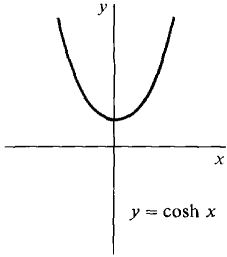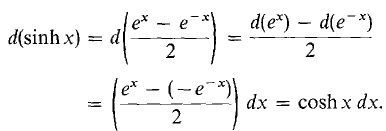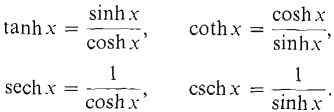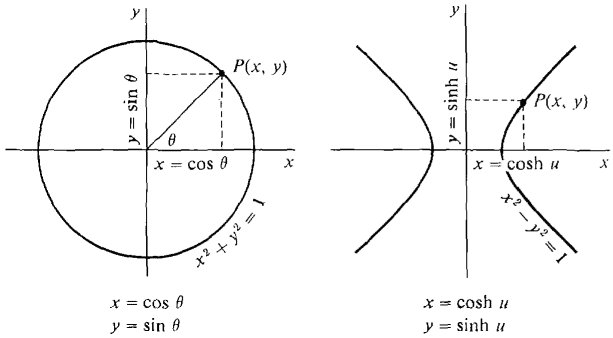| The ebook Elementary Calculus is based on material originally written by H.J. Keisler. For more information please read the copyright pages. |

|

Home  Exponential and Logartihmic Functions Exponential and Logartihmic Functions  Some Uses of Exponential Functions Some Uses of Exponential Functions  Hyperbolic Functions Hyperbolic Functions |
|||||||||||||
| See also: Example 7 | |||||||||||||






|
|||||||||||||
Hyperbolic Functions
In this section we shall discuss some functions involving exponentials which come up in physical and social sciences. The hyperbolic functions are analogous to the trigonometric functions and are useful in physics and engineering. The hyperbolic sine, sinh, and the hyperbolic cosine, cosh, are defined as follows.
A chain fixed at both ends will hang in the shape of the curve y = cosh x (the catenary). The graphs of y = sinh x and y = cosh x are shown in Figure 8.4.1.
Figure 8.4.1 The hyperbolic functions have identities which are similar to, but different from, the trigonometric identities. We list some of them in Table 8.4.1.
These hyperbolic identities are easily verified. For example,
Notice that
When we multiply these we get the identity cosh2 x - sinh2 x = 1. The other hyperbolic functions are defined like the other trigonometric functions,
The hyperbolic functions are related to the unit hyperbola x2 - y2 = 1 in the same way that the trigonometric functions are related to the unit circle x2 + y2 = 1 (Figure 8.4.2).
Figure 8.4.2 If we put x = cos θ, y = sin θ, we have x2 + y2 = cos2 θ + sin2 θ = 1, so the point P(x, y) is on the unit circle x2 + y2 = 1. On the other hand if we put x = cosh u, y = sinh u, we have x2 - y2 = cosh2 u - sinh2 u = 1, so the point P(x, y) is on the unit hyperbola x2 - y2 = 1. The hyperbolic functions differ from the trigonometric functions in some important ways. The most striking difference is that the hyperbolic functions are not periodic. In fact both sinh x and cosh x have infinite limits as x becomes infinite:
Let us verify the last limit. If if is positive infinite, then
is the sum of a positive infinite number ½ eH and an infinitesimal ½ e-H and hence is positive infinite. Therefore limx→∞ cosh x = ∞.
|
|||||||||||||
Home  Exponential and Logartihmic Functions Exponential and Logartihmic Functions  Some Uses of Exponential Functions Some Uses of Exponential Functions  Hyperbolic Functions Hyperbolic Functions |
|||||||||||||
Last Update: 2006-11-16










